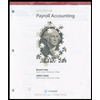Use the following tax rates, ceiling and maximum taxes to solve the problem below Employee and Employer OASDI: 6.20% $127,200 $7,886.40 Employee* and Employer HI: 1.45% No limit No maximum Self-employed OASDI: 12.4% $127,200 $15,772.80 Self-employed HI: 2.9% No limit No maximum *Employee HI: Plus an additional 0.9% on wages over $200,000. Also applicable to self-employed. Rounding Rules: Unless instructed otherwise compute hourly rate and overtime rates as follows: 1. Carry the hourly rate and the overtime rate to 3 decimal places and then round off to 2 decimals places (round the hourly rate to 2 decimal places before multiplying by one and one-half to determine the overtime rate). 2. If the third decimal place is 5 or more, round to the next higher cent. 3. If the third decimal place is less than 5, drop the third decimal place. Use the minimum hourly wage of $7.25 PROBLEM: Beginning with the first pay of the year, Carson will make $2,700 each week. In which numbered pay period of the year will Carson hit the OASDI taxable limit?
Use the following tax rates, ceiling and maximum taxes to solve the problem below
Employee and Employer OASDI: 6.20% $127,200 $7,886.40
Employee* and Employer HI: 1.45% No limit No maximum
Self-employed OASDI: 12.4% $127,200 $15,772.80
Self-employed HI: 2.9% No limit No maximum
*Employee HI: Plus an additional 0.9% on wages over $200,000. Also applicable to self-employed.
Rounding Rules: Unless instructed otherwise compute hourly rate and overtime rates as follows:
1. Carry the hourly rate and the overtime rate to 3 decimal places and then round off to 2 decimals places (round the hourly rate to 2 decimal places before multiplying by one and one-half to determine the overtime rate).
2. If the third decimal place is 5 or more, round to the next higher cent.
3. If the third decimal place is less than 5, drop the third decimal place.
Use the minimum hourly wage of $7.25
PROBLEM: Beginning with the first pay of the year, Carson will make $2,700 each week. In which numbered pay period of the year will Carson hit the OASDI taxable limit?
Trending now
This is a popular solution!
Step by step
Solved in 2 steps









